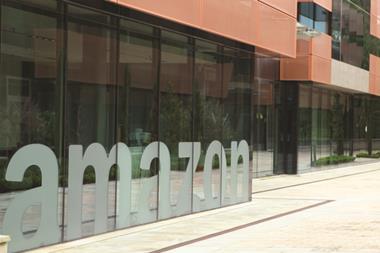With rumours of Amazon entering the motorcycle and car insurance market, Insurance Times takes a closer look at how it might affect the industry
The FCA’s proposal to ban dual pricing is potentially a “catalyst” for tech giant Amazon to enter the insurance market.
The regulator’s move could also open the market to other like-minded players and reduce reliance on price comparison websites (PCWs), according to Greg Brown, partner at insurance management consultants Oxbow Partners.
He told Insurance Times that the FCA’s move could put Amazon in a unique position. Brown said: “If PCWs lose dominance, then the Amazon value increases.”
In September, rumours about Amazon’s entry into the motorcycle and car insurance market circled after it snapped up Indian insurtech Acko.
Partnering with an insurtech instead of an incumbent highlights “the retailer’s desire to work with digital and agile companies”, according to GlobalData analyst Ben Carey-Evans.
With the insurance industry historically slow to innovate, how could Amazon’s presence in the market disrupt competition?
Not ‘if’ but ‘how’
Over the past six months, insurance market intelligence platform Sønr has seen a huge upswing in clients tracking investment, acquisitions and innovation activity by Amazon.
For Matt Connolly, Sønr’s founder and chief executive, the best case scenario is that Amazon could push insurers into a back office function. However, in the worst case, incumbent insurers could lose significant market share.
“It’s no longer a question of ‘if’ they move into insurance, but rather ‘how?’,” Connolly said.
“Most of Amazon’s revenue comes from the US, UK and Germany – which market will be next?”
He said the “sheer scale of Amazon’s ability to distribute will hurt the comparison sites” regardless of its partners. Connolly added that, depending on the innovation it brings to each market and its partner choice, there is the potential to disrupt all aspects of the value chain.
He recommended that insurers in motor, home, health or life keep their eyes on Amazon’s activity. As for brokers, Connolly said there could be a “tonne of disintermediation” as customers go directly to Amazon for insurance, but added it might only affect those in mainstream business-to-consumer insurance lines.
Regulation and relationships
Paul De’ath, head of market intelligence at Oxbow Partners, highlighted that Amazon has a tremendous amount of data on customers and, therefore, could offer more individualised cover.
Brown questioned whether Amazon will connect this data to underlying risks.
He also pointed out that, because of regulation, the technology giant will need a separate underwriter to enter the insurance sector. But if Amazon created its own insurance proposition, he said it could act as a broker with an insurer panel.
Patrick Hayward, consultant at Altus, said Amazon’s partnership with Acko could also be a “template for disruption in any territory”.
He said: “Ultimately, Amazon’s role in this relationship as a large distribution channel and user interface for claims means that it does not need extensive experience of pricing and underwriting or repairing vehicles to provide this product.”
Hayward warned against underestimating the importance of the Acko partnership, as it combines distribution with data analytics and tech. Robin Merttens, co-founder and partner in insurance tech network InsTech London agreed, adding that the industry’s response during the Covid-19 pandemic left customer trust levels at an “all-time low”.
Amazon, however, already has a relationship with customers, but it could look to insurers to provide risk capital. Home insurance could be next after motor, according to Carey-Evans.
He said: “Amazon undoubtedly poses a threat to home insurers. There have been several strong indications that it is moving towards the personal lines markets in recent years.
“Amazon has an established presence in many households across the UK, in the form of Alexa, which would make a link up to home insurance easier.”
GlobalData’s 2019 Insurance Consumer Survey found that 18.8% of UK consumers would be happy to switch home insurers to Amazon.
Although this indicates that most consumers are unwilling to switch, GlobalData said that the online giant could get around this by creating its own insurance brand under a different name.
Struggle to innovate
Connolly said two fundamental questions remain – are the market conditions attractive enough and does Amazon have an appetite for insurance?
Despite insurance being highly regulated and competitive, he said: “From the business side, there is a vast amount of money currently sitting on the insurance table, an industry desperately aware of the need to innovate and yet struggling to do so.”
Most insurance policies are bought annually or with an item – so the opportunity for the retailer to offer insurance is there. Paul Williams, insurtech Ripe Thinking’s chief executive, sees Amazon’s move as a positive one for consumers.
He said: “The future success of Amazon in insurance will depend on its ability to seamlessly connect its customer base to simple, clear, compelling and competitive insurance products served digitally in a few clicks.”
Amazon was approached for this article but declined to comment
Sønr’s timeline of Amazon’s insurance entry (Source: Sønr)
2015
December: Amazon invest in Housejoy’s Series B funding, which offers all sorts of home services.
2016
April: Amazon launches Amazon Protect in Britain in April 2016 with The Warranty Group’s London General Insurance Company. Expanding to its main European markets – France, Germany, Italy and Spain.
2018
May: Amazon leads a $12m investment round into Acko.
June: Announces chief executive for its new unnamed healthcare joint venture and acquires online pharmacy PillPack for just under $1bn.
August: Reuters reports Amazon has approached insurance figures about a comparison site.
September: Amazon makes u-turn on insurance entry.
October: Tie-up with Travelers Insurance in the US.
2019
February: Amazon invests in Rivian, an electric vehicle company.
Mar: Amazon leads Acko’s Series C funding round.
April: Six healthcare organisations allow customers access to their personal medical information via Amazon Alexa voice tools.
May: Amazon launch healthcare website with Berkshire Hathway and JP Morgan Chase, covering 1.2m of its collective employees.
September: Amazon launches health care plan – Amazon Care for its employees.
December: Amazon invests further in Rivian.
2020
January: SSP and Amazon Web Services team up to bolster broker management software and LV= launches a voice skill for car insurance customers.
July: Acko offer motor cover via Amazon Pay in India; the payments service’s chief executive Mahendra Nerurkar says Amazon plans to expand into health, flight and cabs.
August: Launched Halo, a health and fitness wearable, and announced a partnership with life insurer John Hancock.
September: Amazon-Acko latest funding round $60m. Tech giant also reveals plans to expand Ring video doorbell via a video drone to spot intruders.














































No comments yet